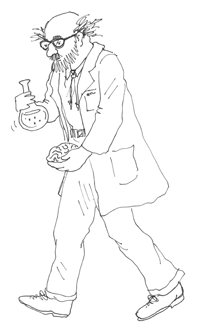STRANGE BUT TRUE- Weird scientist: What if they don't really wear lab coats?

DRAWING BY DEBORAH DERR McCLINTOCK
Q. Why does Hollywood tend to depict scientists as nerds, villains, or occasionally heroes instead of the more realistic types they obviously are?–S. Hawking
A. Few people actually know real scientists, says Sidney Perkowitz in Hollywood Science. For example, in recent years, the U.S. has turned out about 26,000 scientists and engineers annually, plus thousands of physicians, but among the general population, this computes to only about 1 in 300 Americans being a scientist.
"Unless you are one, chances are you've never encountered a laboratory scientist, and so it matters whether movies get it right, which they do– but only partly."
Often, movie scientists are introduced on screen as "Doctor" or "Professor," dressed in the traditional white lab coat, as worn by the original Dr. Henry Frankenstein. Wild hair, a beard, and thick, stodgy eyeglasses, as with Dr. Brackish Okun in Independence Day, are also part of the code, adding an air of implied intelligence.
In truth, white coats are optional, and "Doctor" is used sparingly among real scientists. More on target, "I've observed at science conferences about a third of the men have facial hair, and male or female, half wear glasses, though few in clunky black."
Regarding scientists' deeper qualities, here too there's some basis for film depictions. Many real scientists do tend to put their work above other things in life, and high I.Q.s are typical.
Some evidence also suggests they score lower in so-called social or emotional intelligence. Maybe it's the too-long hours and years in grad school, or scientists just may be serious because they tend to think science is seriously important. Yet few of them have a desire to rule the world. "Many simply want to be left alone to do what they adore."
But that's hardly the stuff of blockbuster filmmaking.
Q. Gloomy prognosticator Thomas Malthus stated 200 years ago that population tends to outstrip the Earth's food-growing capacity, and so it's just a matter of time before widespread starvation hits. Was he too gloomy?–P. Singer
A. Malthus would have been surprised at what science and technology have done for food production in the intervening years, say Daniel Botkin et al. in Environmental Science: Earth As a Living Planet.
For instance, population increased 122% from 1950 to 1995, but world grain productivity grew 141%! Malnutrition and starvation do of course occur today, but these are more problems of distribution, not overall supply.
However, food production has dipped in recent years, with water supply becoming critical in many areas. Many Malthusians insist widespread famine can be averted only if nations check population growth; anti-Malthusians believe technology will save the hungry human race.
How hungry? China, with a fifth of the world's people (1.2 billion) has actually cut its fertility rate from 4.8 children/woman to less than 2 in recent decades. Still, says Botkin, if China ate fish at the rate of the Japanese, it would consume the entire world's supply. Just to feed all of China's chickens so everyone could reach the target goal of 200 eggs/person/year would require all the grain exports of Canada– the world's second largest exporter.
We can all celebrate past successes, but any prognosticator would say there are critical years ahead.
Q. How many golf balls laid edge to edge would it take to circle the Earth at the equator?–T. Woods
A. That's a 25,000-mile (40,000 km) necklace done up with 2-inch diameter balls, which computes to 25,000 miles times 5,280 feet/mile times 6 balls/foot, say Lawrence Weinstein and John A. Adam in Guesstimation: Solving the World's Problems on the Back of a Cocktail Napkin.
This comes to roughly a billion golf balls (1,000,000,000). Now, if you picture just one of these balls, it represents "one part per billion (ppb)," a common ratio in environmental science. This means that if the air, water or soil contains so many ppb of some potentially toxic substance, that is about the number of, say, red golf balls among the otherwise white ones surrounding the Earth. "You could walk along the equator for months before finding your first red golf ball."
If you don't feel like walking, try waiting a while– a long while. One part per billion is equivalent to one minute in 1,901 years!
Q. What's the spoon test for demonstrating the awfulness of a cup of long-brewed coffee served in a second- rate restaurant?–Cora
A. Before you stick in the spoon, the coffee surface lacks any luster, which is unappealing enough, says Jearl Walker in The Flying Circus of Physics.
Now stick it in and the surface suddenly displays small shining circles, which is even worse! Usually bad coffee is bad because of an oily layer on top, dulling the appearance. The spoon can carry material on it that spreads out on the liquid surface, squeezing the oil into drops whose curved surfaces act as small reflectors of any overhead lamps. "When you pull the spoon out, the oil layer reforms and most of the circular reflections disappear."
~
Send strange questions to brothers Bill and Rich at [email protected].
#